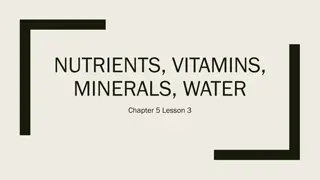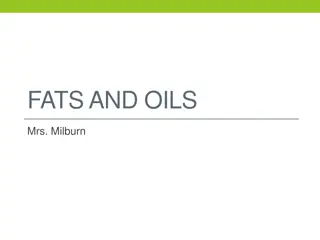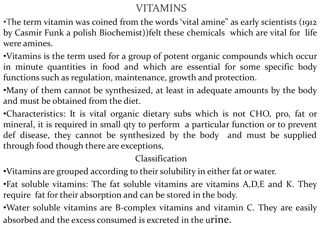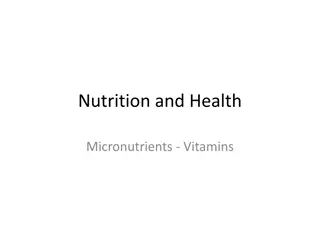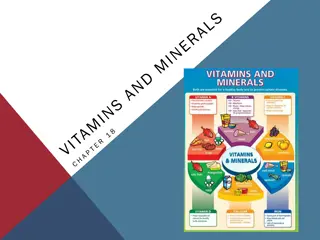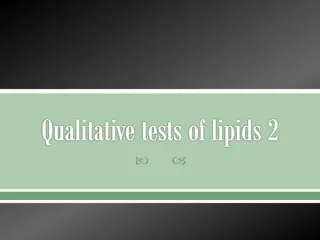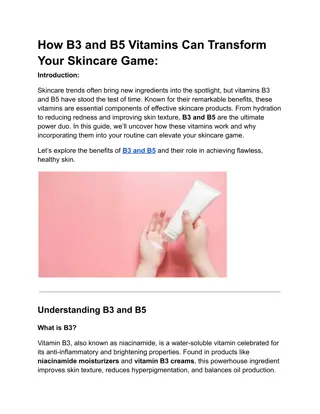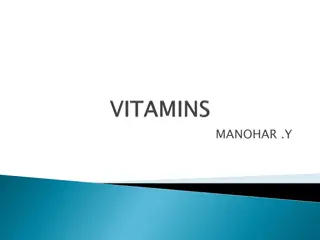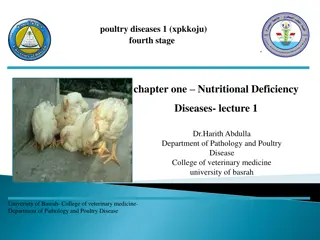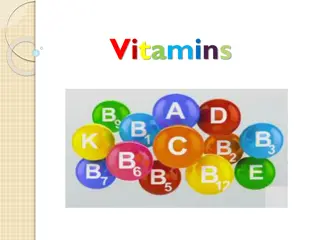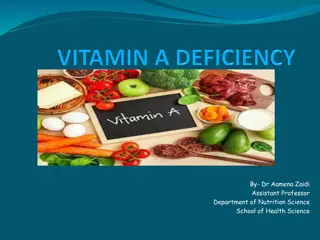Water-Soluble Vitamins Overview
Water-soluble vitamins like Vitamin C and B complex play vital roles in the body's functioning. Learn about types, deficiency risks, and benefits of consuming these essential nutrients regularly from foods like green vegetables and fresh fruits.
Download Presentation

Please find below an Image/Link to download the presentation.
The content on the website is provided AS IS for your information and personal use only. It may not be sold, licensed, or shared on other websites without obtaining consent from the author.If you encounter any issues during the download, it is possible that the publisher has removed the file from their server.
You are allowed to download the files provided on this website for personal or commercial use, subject to the condition that they are used lawfully. All files are the property of their respective owners.
The content on the website is provided AS IS for your information and personal use only. It may not be sold, licensed, or shared on other websites without obtaining consent from the author.
E N D
Presentation Transcript
StudyMafia.Org Water Soluble Vitamins Submitted Studymafia.org Studymafia.org Submitted To: To: Submitted Submitted By: By: Studymafia.org Studymafia.org
Table Contents Definition Introduction Types of Water Soluble Vitamins Deficiency of Water Soluble Vitamins Conclusion 2
Definition Water-soluble (washed out and not easily stored). Water-soluble vitamins can be consumed easily regularly any foods, especially green vegetables and fresh fruits, are vibrant with vitamins. 3
Introduction The water-soluble vitamins are Vitamin C and Vitamin B complex. The types of vitamin B are thiamine, riboflavin, niacin, pantothenic acid, pyridoxine, biotin, folate, and cobalamin. The Extreme lack of water-soluble vitamins is rare in North America. For those who consume alcohol in high amounts, malabsorption syndromes, strict veganism, and malnourished states also cause vitamin deficiency in their body. 4
Types of Water Soluble Vitamins Thiamine (Vitamin B1) Thiamine, also known as vitamin B1, was the first water-soluble vitamin to be described scientifically. Like the other B vitamins, thiamine serves as a coenzyme in the body. This applies to all its active forms, but thiamine pyrophosphate is the most important one. 6
Types of Water Soluble Vitamins Riboflavin (Vitamin B2) Riboflavin is the only water-soluble vitamin used as a food coloring. In fact, it is named for its color the Latin word flavus means yellow. Like thiamine, it is involved in the conversion of nutrients into energy. It is also required in the conversion of vitamin B6 to its active form, and in the conversion of tryptophan to niacin (vitamin B3). 7
Types of Water Soluble Vitamins Niacin (Vitamin B3) Niacin, also known as vitamin B3, is the only B vitamin your body can produce from another nutrient the amino acid tryptophan. All dietary forms of niacin are eventually converted into nicotinamide adenine dinucleotide (NAD+) or nicotinamide adenine dinucleotide phosphate (NADP+), which act as coenzymes. 8
Types of Water Soluble Vitamins Pantothenic Acid (Vitamin B5) Pantothenic acid is found in virtually all food. Appropriately, its name is derived from the Greek word pantothen, which means from every side. It is required for the formation of coenzyme A, which is necessary for the synthesis of fatty acids, amino acids, steroid hormones, neurotransmitters and various other important compounds. 9
Types of Water Soluble Vitamins Biotin (Vitamin B7) People often take biotin supplements to nourish their hair, nails and skin, although strong evidence for these benefits is lacking. In fact, it was historically called vitamin H after the German word haut, meaning skin . Biotin is either found in its free form or bound to proteins. 10
Types of Water Soluble Vitamins Vitamin B9 Vitamin B9 was first discovered in yeast, but later isolated from spinach leaves. For this reason, it was given the names folic acid or folate, words derived from the Latin word folium, meaning leaf. Vitamin B9 acts as a coenzyme and is essential for cell growth, DNA formation and amino acid metabolism. 11
Types of Water Soluble Vitamins Vitamin B6 Vitamin B6 is a group of nutrients that are required for the synthesis of pyridoxal phosphate, a coenzyme involved in more than 100 different metabolic processes. Vitamin B6 also supports the formation of white blood cells and helps the body synthesize several neurotransmitters. 12
Deficiency of Water Soluble Vitamins Lack of any vitamin in the body may cause serious issues. Riboflavin (B2) Deficiency of riboflavin causes infection in lips and mouth. 13
Deficiency of Water Soluble Vitamins Thiamine (B1) Lack of thiamine causes beriberi, which is a severe medical condition. In that case, one starts to lose weight and appetite. They start to feel weak. In some cases, one may lose their memory. 14
Deficiency of Water Soluble Vitamins Niacin (B3) A severe deficiency of niacin can lead to pellagra. It includes dermatitis, dementia, and diarrhea. This kind of disease may carry toward malnutrition and weakness. 15
Deficiency of Water Soluble Vitamins Vitamin C (ascorbic acid, ascorbate) Vitamin C helps in collagen growth, bone formation, enhancing the immune system, absorbing iron, wound healing, strengthening blood vessels, and acting as an antioxidant. That has the symptoms like loss of teeth, poor wound healing, swollen and bleeding gums, and poor tissue growth. 16
Conclusion Vitamins are the organic substances present in natural food supplements. Vitamins are made up of organic molecules, which is an essential micronutrient that helps to function proper metabolism in the body. These essential nutrients cannot be synthesized by themselves. 17
Google.com Wikipedia.org Studymafia.org Slidespanda.com



